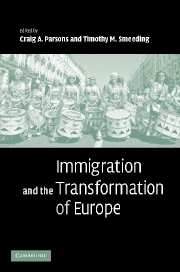Book contents
- Frontmatter
- Contents
- List of figures
- List of tables
- List of contributors
- Acknowledgements
- 1 What's unique about immigration in Europe?
- 2 Europe's immigration challenge in demographic perspective
- 3 Migration into OECD countries 1990–2000
- 4 Divergent patterns in immigrant earnings across European destinations
- 5 Economic consequences of immigration in Europe
- 6 Occupational status of immigrants in cross-national perspective: A multilevel analysis of seventeen Western societies
- 7 Immigrants, unemployment, and Europe's varying welfare regimes
- 8 How different are immigrants? A cross-country and cross-survey analysis of educational achievement
- 9 Immigration, education, and the Turkish second generation in five European nations: A comparative study
- 10 Managing transnational Islam: Muslims and the state in Western Europe
- 11 Migration mobility in European diasporic space
- 12 The new migratory Europe: Towards a proactive immigration policy?
- 13 European immigration in the people's court
- 14 The politics of immigration in France, Britain, and the United States: A transatlantic comparison
- 15 “Useful” Gastarbeiter, burdensome asylum seekers, and the second wave of welfare retrenchment: Exploring the nexus between migration and the welfare state
- 16 The European Union dimension: Supranational integration, free movement of persons, and immigration politics
- 17 The effectiveness of governments’ attempts to control unwanted migration
- Index
- References
6 - Occupational status of immigrants in cross-national perspective: A multilevel analysis of seventeen Western societies
Published online by Cambridge University Press: 23 June 2009
- Frontmatter
- Contents
- List of figures
- List of tables
- List of contributors
- Acknowledgements
- 1 What's unique about immigration in Europe?
- 2 Europe's immigration challenge in demographic perspective
- 3 Migration into OECD countries 1990–2000
- 4 Divergent patterns in immigrant earnings across European destinations
- 5 Economic consequences of immigration in Europe
- 6 Occupational status of immigrants in cross-national perspective: A multilevel analysis of seventeen Western societies
- 7 Immigrants, unemployment, and Europe's varying welfare regimes
- 8 How different are immigrants? A cross-country and cross-survey analysis of educational achievement
- 9 Immigration, education, and the Turkish second generation in five European nations: A comparative study
- 10 Managing transnational Islam: Muslims and the state in Western Europe
- 11 Migration mobility in European diasporic space
- 12 The new migratory Europe: Towards a proactive immigration policy?
- 13 European immigration in the people's court
- 14 The politics of immigration in France, Britain, and the United States: A transatlantic comparison
- 15 “Useful” Gastarbeiter, burdensome asylum seekers, and the second wave of welfare retrenchment: Exploring the nexus between migration and the welfare state
- 16 The European Union dimension: Supranational integration, free movement of persons, and immigration politics
- 17 The effectiveness of governments’ attempts to control unwanted migration
- Index
- References
Summary
Introduction
It is well documented that micro-level factors like human capital and demographic position are important for the incorporation of immigrants in the labor market. Immigrants with a higher education, who are more proficient in the destination language, who have more work experience, and who remained longer in the destination country, generally have a better position in the labor market (McAllister 1995; Poston 1994; Raijman and Semyonov 1995).
Recently macro factors have also received increasing attention from students of the economic integration of immigrants (Model and Lin 2002). One research tradition has shown that, even after taking into account human-capital variables, the country of origin affects immigrants’ economic position (Borjas 1999; Jasso and Rosenzweig 1990; Poston 1994; Raijman and Semyonov 1995). Another line of research suggests that the attainment of immigrant groups also differs between destination countries (Borjas 1988; Model 1997; Model, Fisher, and Silberman 1999; Model and Lapido 1996; Reitz 1998, 2003).
Van Tubergen, Maas, and Flap (2004) combined both macro approaches and suggested that three groups of macro effects strongly affect the economic attainment of immigrants. First, there exists what they call “origin effects,” the impact of countries of origin irrespective of the destination of immigrants. Second, they outline “destination effects,” the impact of receiving societies, notwithstanding immigrants’ origins. Third, there is an influence of the combination of origin and destination, which they called “setting” or “community” effects.
- Type
- Chapter
- Information
- Immigration and the Transformation of Europe , pp. 147 - 171Publisher: Cambridge University PressPrint publication year: 2006
References
- 11
- Cited by



